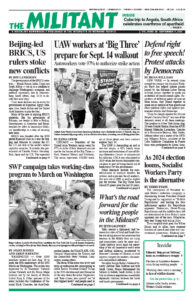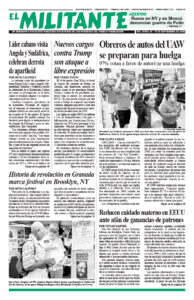“There’s going to be a lot of finger pointing between the city government and the state and the electric company about who’s to blame for the fire,” Sergio Alcubilla, executive director of the Honolulu-based Hawaii Workers Center, told the Militant by phone from Maui Aug. 30. “They all claim there was no forewarning.”
The government’s negligence included no organized evacuation, a decision not to set off the siren alarms, and the collapse of the water pressure needed to fight the fires.
Alcubilla was on his way back from a fact-finding tour in Lahaina. “You still see miles of dry brown grasses” that hasn’t burned yet, he said. He was referring to the invasive plants that have taken over thousands of acres after the island’s sugar plantations shut down. This was the fuel for the fast-moving wildfire that destroyed the town Aug. 8, leaving at least 115 people dead.
“This is the third major fire here in recent years,” he said. “A firefighter friend called it a tinderbox.” Neither the government, Hawaii Electric bosses nor big-business landowners took any serious preventive measures.
Some 6,000 of the town’s 13,000 residents — many forced to flee with just the clothes on their backs — are being housed in hotels and Airbnbs with some aid from the Federal Emergency Management Agency and other government organizations, and help by volunteers and union donations. But there is no plan for where they’ll go when that money runs out.
“Those most directly impacted are the working class and immigrant communities,” Alcubilla said. The majority of Lahaina residents are immigrant workers, including 40% Filipinos; 13% Latinos, mostly Mexicanos; and 10% Pacific Islanders. Native Hawaiians make up a smaller percentage. The tourist industry and remaining pineapple plantations depend on low-paid immigrant labor.
While there is some government aid for U.S. citizens and others with government-recognized papers, among immigrants “there is a lot of distrust of the government,” Alcubilla said.
Many immigrants worry if they apply for aid or housing they could end up being deported or hurt their chances for permanent residency in the future. “They’re suspicious about FEMA,” Kevin Block, an immigration attorney on Maui told the press. At the shelters, FEMA people wear uniforms. “They look like cops.”
In some cases this means “20, 30 people in a two-bedroom house trying to huddle up and wait it out,” Cassi Yamashita, from Maui Economic Opportunity, said. The Koinonia Pentecostal Church is putting up 20 members of the Filipino congregation in its parish hall.
The Workers Center has called on the government to start paying unemployment benefits to those who lost their jobs, and let them produce documentation later, which many lost in the fire.
“The real question will be, what’s the rebuilding going to look like?” Alcubilla said. “What kind of work are people going to do? So much of the economy depends on tourism, but right now tourism has gone down.”
Trying to prevent ruthless real estate speculators from rapidly buying up Lahaina property, the state is considering a moratorium on sales of destroyed homes. “But that’s also a challenge for people who decide they can’t rebuild and want to move,” he said.
“The concern is that once the spotlight recedes, things will go back to the status quo,” Alcubilla said. That would mean the land speculators and bosses who own the hotels, restaurants and other tourist facilities would end up being the big winners.
“The voice missing here is the working class.”

